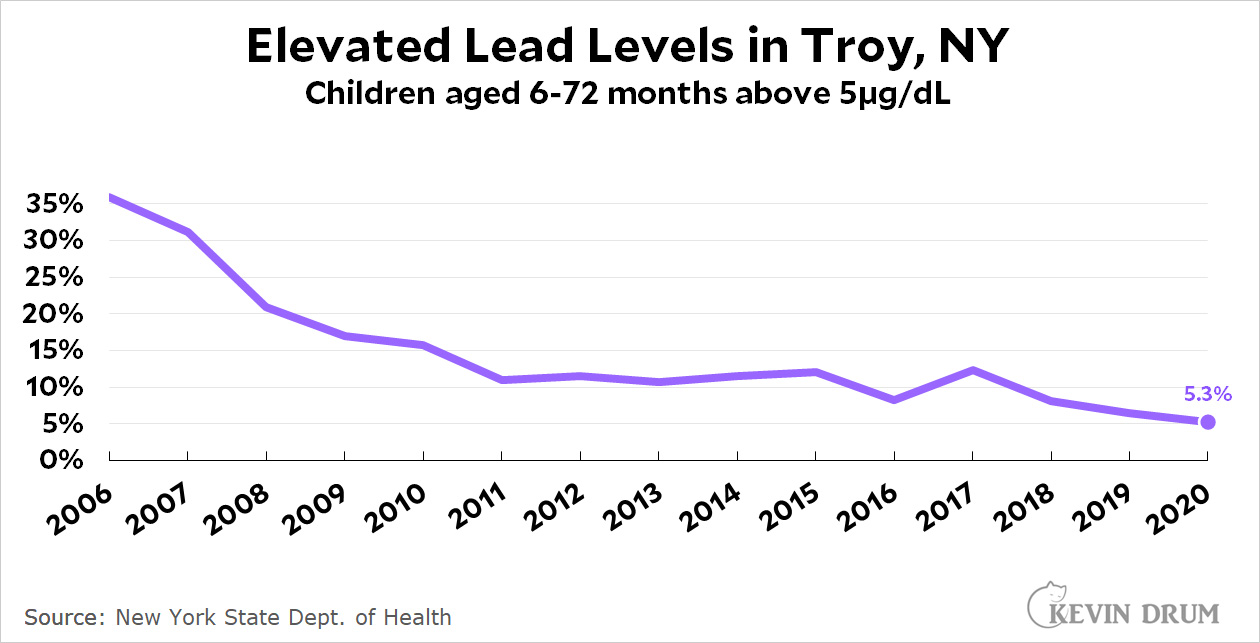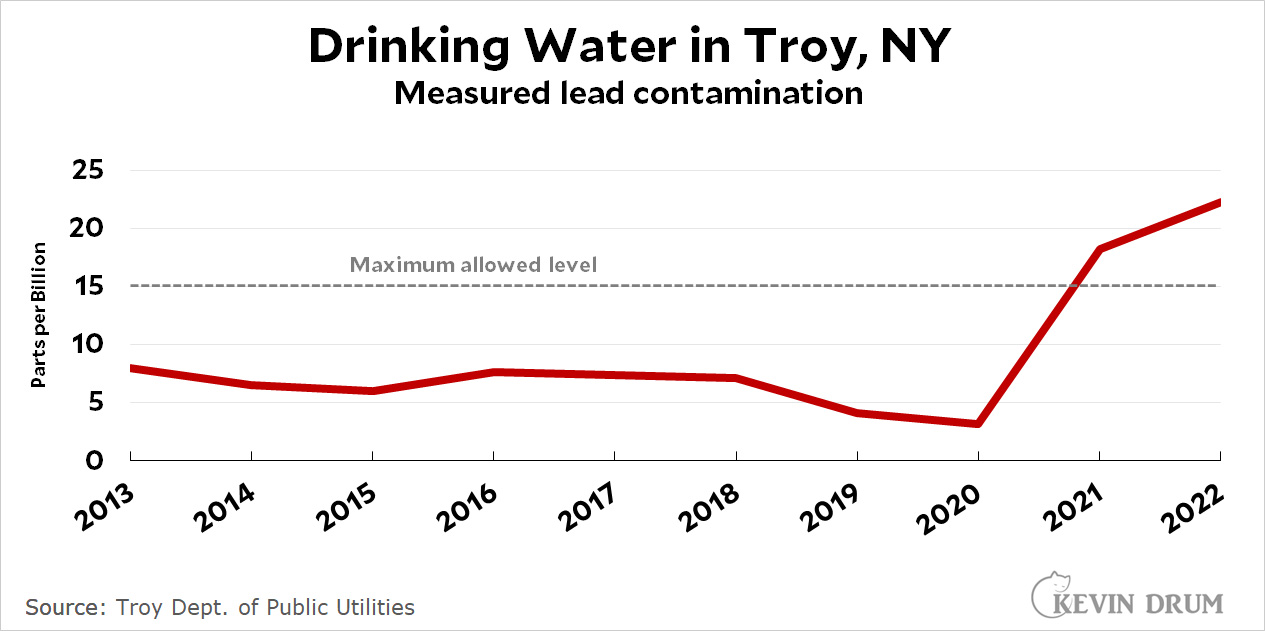Today I read this story in the Guardian:
In 2018, almost 30 cities across New York state received federal money to carry out a specific, urgent task: removing lead service lines that poison drinking water. The city of Troy — which sits across the Hudson River and just north of Albany — was among them, receiving $500,000. But five years later, city leaders have failed to spend a single dollar of that money, and have yet to remove a single lead pipe.
This got me curious about how bad the lead situation was in Troy. I'll have more to say about this in a minute, but first let's review the data. Here is the prevalence of childhood lead poisoning in Troy:
 This is for two of Troy's three ZIP codes (the third one has never been tested for some reason). The numbers are straight out of a spreadsheet from the New York Department of Health.
This is for two of Troy's three ZIP codes (the third one has never been tested for some reason). The numbers are straight out of a spreadsheet from the New York Department of Health.
And although it's good to see the numbers going down steadily, they are still astronomical.¹ The average for the entire country in 2020 was less than 1%. Is water the cause of this?
 Up through 2020, Troy's drinking water was fine, and its lead contamination had gone neither up nor down. That doesn't make it a likely culprit for either the generally high levels of lead poisoning or the steady decline in lead poisoning.
Up through 2020, Troy's drinking water was fine, and its lead contamination had gone neither up nor down. That doesn't make it a likely culprit for either the generally high levels of lead poisoning or the steady decline in lead poisoning.
Then, in 2021, Troy's water suddenly went nuts. Lead contamination rose more than 500% and then went up some more in 2022. What on earth could have caused that?
And did it affect the level of lead poisoning among Troy's children? We don't know because we don't yet have testing figures for 2021 and 2022.
And that finally gets me to the point I want to make about all this. Troy should unquestionably examine why the lead level in its water suddenly spiked in 2021. That's weird as hell.
That said, the data doesn't seem to suggest that water is really the problem. It just doesn't fit the lead poisoning data. More likely, I think, is that Troy's lead poisoning comes primarily from exhaust pipe lead suspended in the soil. Little kids play outside, pick up lead on their fingers, and then lick it off.
Water is always the first culprit whenever an area has high lead levels and wants to know why. But it's not the only possibility, or even the most likely one. It will take further testing to figure out what's going on in Troy, but just in general I wish we used a lot more lead remediation funding to fix soil instead of lead pipes.²
¹It's worth noting that although Troy has a lot of toddlers with test levels above 5 μg/dL, they haven't reported a single test level above 10 μg/dL since 2018. There are too many kids with lead levels that are too high, but they aren't apocalyptically high.
²Another reason to focus more on lead in soil is that there's nothing parents can do to protect their children from it. Lead in drinking water, by contrast, can be fixed via filtration. This isn't a good solution if the problem is widespread, but if it's limited to a small percentage of homes it's probably a better use of money than digging up every water service line in a city.

Wonder if they changed labs or lab methodology.
Google paid 99 dollars an hour on the internet. Everything I did was basic Οnline w0rk from comfort at hΟme for 5-7 hours per day that I g0t from this office I f0und over the web and they paid me 100 dollars each hour. For more details
visit this article... https://createmaxwealth.blogspot.com
water is usually treated to make sure it doesn't scour lead service lines. if someone stops adding those buffering agents, the lines which were never a problem before, can become a problem later.
Maybe the water was safer at schools and starting in 2020 the kids were at home a lot more and exposed to the water there that had more lead.
This does remind us we can do better observability across every "data" category, not just software-related stuff, we're about to enter a brand new era of intention and innovation.
Kids in flint are getting lead exposure alright… from bullets!
In Flint the lead exposure happened because the Governor's people in charge of the water plant decided to stop treating the water to keep it from eroding the scale that lined the lead pipes. The scale coating was a barrier between the water and the lead.
They thought they could save money. $100 a day.
Any whiz kids like that saving money in Troy?
Flint was a whole series of “ands” including but not limited to going years buying water from Detroit without a contract in place, Detroit charging as much money as they could for that water, looking to get a new supply brought online, and Detroit playing “hardball” by shutting off the proverbial tap once it became clear Flint was indeed going to switch.
...and old housing stock.
Water still has to be dealt with before it starts being a major problem, but you're right--other mitigation measures are needed.
Saying that the lead comes from the soil instead of the water does not answer the question of why the test results suddenly jumped up. In fact water, as something centrally distributed, is more plausible than soil. Why would kids all over town suddenly start eating lead-contaminated dirt (or doing anything to be exposed)?
But of course house pipes and local feeders are not too plausible either, although it will be necessary to see the geographical distribution of the high test results. Evidently the Troy authorities have not gotten around to studying this, or Kevin would mention it (wouldn't he?).
There is no jump in contamination among children in the charts. The jump is in the amount of lead in the tested water.
Yes, I was confounding the two data sets - two apparently different problems.
For the overall level in infants, how does this compare with other comparable places? Why would Troy be higher if the contamination is from lead in soil, coming from auto exhaust?
For the lead in water, geographic distribution within the city could be critical. Or of course some change in water chemistry, as in Flint.
And why would there be lead-contaminated car exhaust particles in Troy, NY neighborhoods in 2020? The US banned leaded gasoline decades ago. Now the Troy-Schenectady area is full of all kinds of old, incredibly polluted former industrial sites, so it's possible that something happened to suddenly contaminate the city wells or something, but I don't see what that has to do with kids playing in dirt.
"That said, the data doesn't seem to suggest that water is really the problem"
This to me is completely wrong based on the data you are presenting.
Your graphs don't have the same timelines, and when you look at the periods for which both graphs have data (2013-2020) they both overlap fairly well. Mostly a flat line with a slight decrease starting around 2017-2018.
The soil reason to me also seems unlikely. Leaded fuel was phased out long ago, which explains the gradual decline seen in the graph from 2006 and onwards until it plateaus to a level consistent with the water lead level.